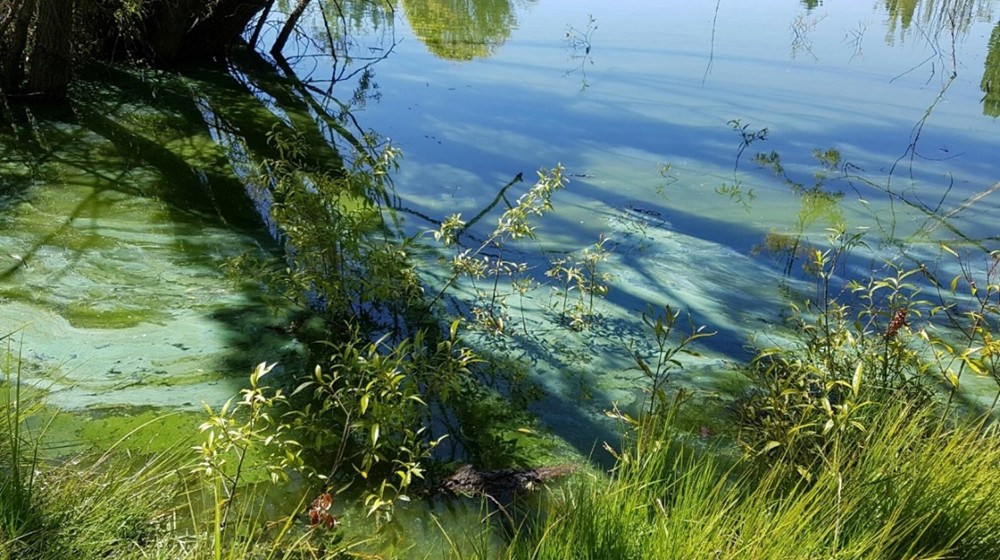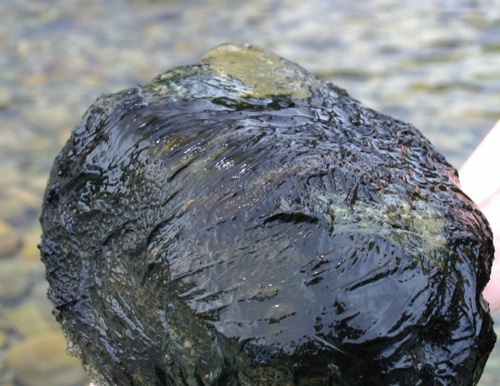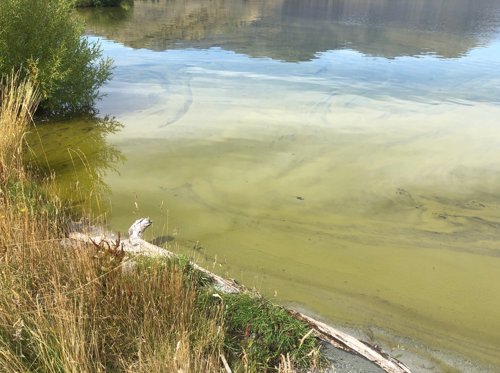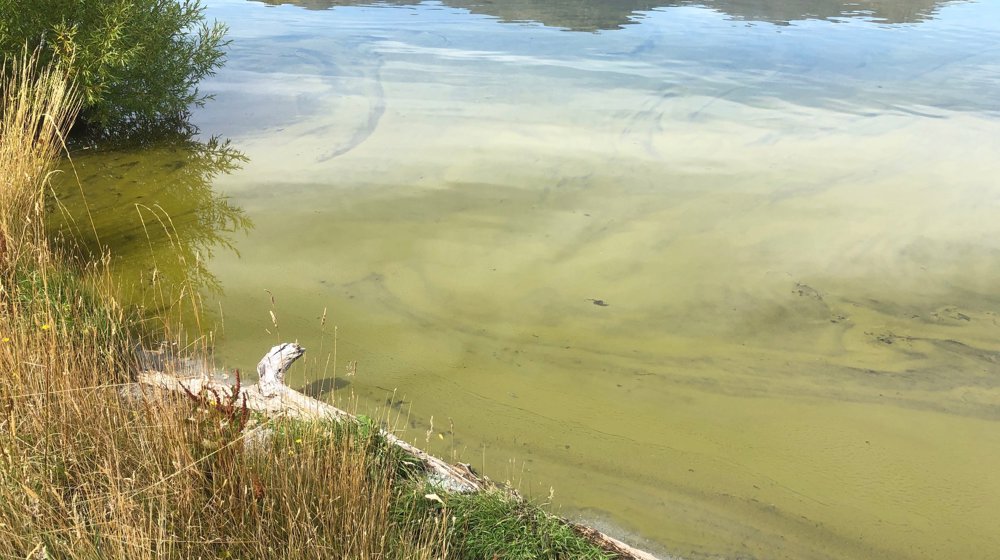
Toxic algae
| Common name: | Toxic algae, cyanobacteria, blue-green algae |
| Scientific name: | Various species |
| Management programme: | Monitored |

Report this pest!
If you think you have seen this pest, we need to know. Please report it.
Toxic algae, or cyanobacteria, naturally occur in rivers and lakes throughout Otago. Toxic algae can grow rapidly and form ‘blooms’, most commonly during the summer months. Toxins produced by these blooms can be harmful to human and animal health.

Toxic algae in rivers
Toxic algae generally form brown or black mats that grow on the river bed. Mats may come loose and float downstream, wash up on banks, or become caught up with other river debris. When the mats die and dry out, they become light brown or white.
The more brightly coloured long green algae commonly found in rivers and streams are harmless algae that don't produce toxins.

Toxic algae in lakes
In lakes, ponds and slow-flowing waters, toxic algae grow in a free-floating form that gives the water murky a or cloudy appearance, like green pea soup. It can be visible as small globules suspended in the water or form scums on water’s surface, especially at the water’s edge. While blooms are generally green, they can vary in colour from red to bright blue.
Dogs are particularly susceptible to poisoning, as they can be attracted to the musty smell of toxic algae mats — if eaten it can cause severe poisoning or death. In extreme cases death can occur within 30 minutes after signs first appear.
Livestock are also at risk of poisoning from toxic algae and should be provided with alternative drinking water.
Symptoms of poisoning in animals include:
- Lethargy
- Muscle tremors
- Fast breathing
- Twitching
- Paralysis
- Convulsions
If your dog experiences symptoms toxic algae poisoning, treat it as an emergency and contact a veterinarian immediately.
Swallowing water containing toxic algae leads to vomiting, diarrhea, abdominal pain, and nausea. Skin contact can cause irritation of the skin, eyes, nose, and mouth. The toxins can also affect the liver and the nervous system.
Whether an exposure causes adverse health effects is determined by a number of factors including the toxin type and concentration, duration and route of exposure, and existing conditions in the person that may make them more vulnerable to illness.
Monitor for symptoms. If you think you are experiencing a reaction after exposure to water containing toxic algae, see urgent medical attention. Let your doctor about potential contact with toxic algae, so they can inform Regional Public Health.
Stay informed and know what to look for. If there has been an alert issued or you think you have spotted toxic algae keep your dog on a lead and out of the water. Ensure they do not lick or eat any algae mats. If your dog has been in the water try to keep them from licking their fur and give them a wash with fresh water.
No, water containing toxic algae should not be consumed. Toxins are not removed by boiling or normal filtration systems.
No, avoid swimming in water where toxic algae is present. Keep out of the water and do not touch the algae. If you do swim in water that is contaminated with toxic algae, rinse off with fresh water as soon as possible.
No, a wetsuit will not protect you and may cause severe irritation around the collar and cuffs.
This depends on the amount of direct contact with the water. If you swallow the water or your skin is in contact with the water while boating or canoeing, you are at risk from a reaction to any toxic algae that may be present. The higher the concentrations of toxic algae and the longer that people are in contact with the water, the more likely a reaction is to occur. Wash boats or canoes and life-jackets down with clean water after use.
It is advised to avoid eating shellfish from waters affected by toxic algae, as they may accumulate toxins.
Fish from affected waterways should be consumed in moderation (less than one meal per week). Avoid the liver and kidney where toxins may accumulate. Fish may have a muddy/earthy taste. Avoid contact with the water while fishing and wash fish in clean water.
Toxic alage are naturally occurring and are found in a range of waterways from near-pristine to those more impacted by land-use. Most of the year they are present at low levels that do not present a significant danger.
During warmers months algae growth can increase rapidly. The presence of high levels of toxic algae or ‘blooms’ are linked with environmental conditions which favour their growth - a combination of warm temperatures, sunlight, low or stable river flows, nutrients and fine sediments (e.g. nitrogen and phosphorus).
No. Not all species produce toxins (cyanotoxins) and those that can aren’t always toxic to people. The conditions for when they can become toxic is not well understood, and the levels of toxicity can only be determined by laboratory testing. This is why it is safest to treat the blooms as if they are toxic at all times.
During the summer ORC monitor toxic algae levels at selected river and lake sites across the region. Our monitoring and response approach follows Ministry for the Environment (Mfe) and Ministry of Health (MoH) guidelines.
If toxic algae levels reach moderate-high levels (as specified in the guidelines) ORC notify the community and may install warning signs at popular access points. Notifications are also made via our website, media and LAWA Land Air Water Aotearoa.
Although signs may be installed, due to the widespread and rapidly occurring nature of these blooms, signs will not be present at all sites where there is toxic algae. People and particularly dog-walkers should always exercise caution when playing in and around waterways, especially during the summer months.
No, this algae is typically a non-toxic green algae which is present in rivers when conditions get warm and sunlight hours are longer, similar to your grass growing faster during summer.
Report suspected toxic algal blooms to the ORC Pollution Hotline 0800 800 033 (7 days) or email us on pollution@orc.govt.nz
Photographs of observed algal blooms will help us to quickly identify toxic algae and notify others about potential risks.

Toxic algae warnings
Naturally occurring algae can be toxic and harmful to human and animal health. Learn more about toxic algae and see a list of sighted and confirmed areas with toxic algae in Otago.

Factsheet: Toxic algae
Read the toxic algae factsheet at LAWA Land Air Water Aotearoa website
Monitored
www.orc.govt.nz/toxicalgaeinfo
